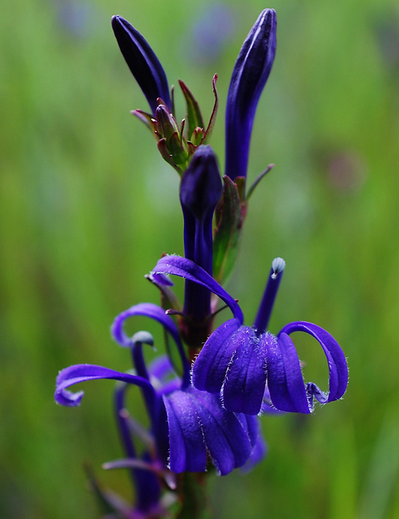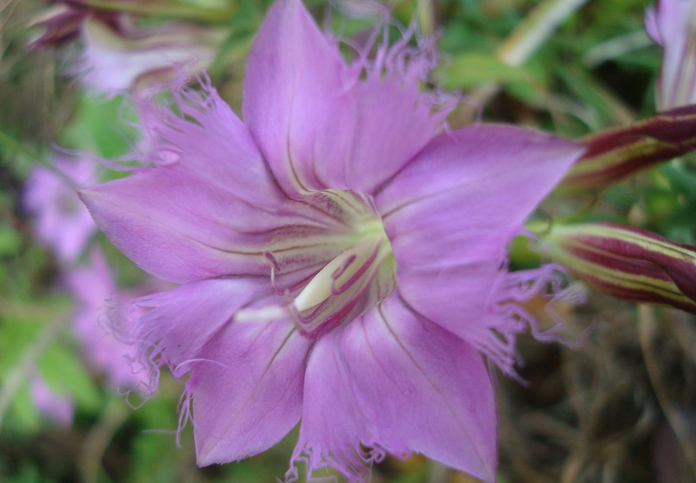There are three points to pay attention to when planting gentian.
Gentian is a perennial herb with a height of 1-2 feet. Leaves opposite, lower leaves 2 murmur3 pairs very small, scalelike, middle and upper leaves lanceolate, surface dark green, abaxially light green, with three distinct veins, without petiole. Peanuts have blue tube-shaped bell-shaped flowers between the axils of branches or proximal shoots. The fruit is long oval and slightly flat, two petals are dehiscent after maturity, and the seeds are numerous and small. Rhizome short, clustered with many slender roots, yellowish brown or yellowish. Now many people plant gentian, so what are the main points of planting gentian? Next, let the editor who decorates the network give you a brief introduction.

There are three points to pay attention to when planting gentian.
I. selection of land and land preparation
It is appropriate to choose a relatively humid area, the terrain is flat, the sun is sufficient, and the soil is sandy soil rich in humus. Poor, sticky soil is not suitable for cultivation.
II. Field management
After sowing, attention should be paid to maintaining the temperature and temperature. when the emergence rate reaches 50%, the cover curtain will be about 30 cm high, and the grass cover will be removed about half evenly to prevent the seedling from being pressed. When the emergence rate reaches 80%, remove the grass curtain and cover the grass. The weeds in the field should be pulled out in time at the seedling stage to prevent grass famine and keep the field clean. Maintain soil moisture. During the growth period, topdressing was carried out 1-2 times a year. After the bud formation, the commercial field should remove the flower bud to promote the root system development. Gentian bogey bright light, can plant shade crops.
III. Pest control
1. Disease
Gentian spot blight: mainly harms the leaves and, in serious cases, causes the whole leaf to die. 1000 times of carbendazim can be used and sprayed every 10 days after summer, the effect is better. And remove the dead branches and leaves in the field before winter and burn them to prevent the spread of germs.
2. Insect pests
The serious harm of mole cricket and grub can be used for soil disinfection during soil preparation and prevention and control during the growth period. Soil disinfection can apply 35% endosulfan 0.5-1.5 kg per mu, or phoxim 0.5 kg per mu, mixed in the border soil; mole cricket can be trapped and killed by black light during the growth period.
There are three points to pay attention to when planting gentian.
What effect does gentian have? Planting techniques of Gentiana
[FAQ] what is the effect of gentian? How should I plant it?
[expert answer] Gentiana perennial herb is a common traditional Chinese medicine with high medicinal value and good planting benefit. In this paper, the efficacy and planting techniques of gentian are introduced as follows:
Picture: gentian planting
First, the efficacy of gentian.
1. Clear heat, dryness and dampness: gentian can treat damp-heat jaundice, swelling and itching, subband, strong, eczema pruritus and other diseases.
two。 Purging liver and gallbladder fire: gentian can treat jaundice, bitter mouth, red eyes, deafness, hypochondriac pain and other diseases caused by cholecystitis, gallstones and viral hepatitis.
3. Dispelling fire and calming wind: gentian can treat convulsions caused by fever.
4. Promoting diuresis and relieving dampness: gentian mainly treats eye pain, neck pain, pain on both sides, damp-heat hyperactivity and other diseases.
5. Deworming and digestion: gentian can treat infantile dyspepsia, heat in the stomach, seasonal temperature heat, heat discharge, intestinal worms, liver and gallbladder qi, anti-shock and other diseases.
2. Planting techniques of gentian.
1. Growth habits: gentian likes wet and cool climate, and is wild in mountains, slopes, forest greens and bushes. The temperature requirement of the plant during the whole growing season is quite high, and it has been growing well after introduction in Beijing area. Places with high dryness and direct sunlight and areas where the soil is too sticky and barren are not suitable for cultivation. Like fertilizer, when combined with deep ploughing land, about 8000 jin of mature barnyard manure should be applied per mu. It germinates in the middle of April, blossoms in August, blossoms from August to September, the fruit matures in September, and the annual growth period is about 180-210 days.
Picture: gentian planting
two。 Breeding technology
(1) ramet propagation: the ramet propagation of gentian is mostly carried out before the buds are unearthed in early April. All the roots are dug out and divided into small clusters, each cluster should have 1-2 small buds, and then planted according to row spacing 1.3 feet, plant spacing 0.7-1 feet, do not make the buds exposed to the soil, so as not to be blown dry by the wind.
(2) seed propagation: the seed propagation of Gentiana can be divided into autumn sowing and spring sowing. Autumn sowing is usually sown in November and sprouting in the following spring. In order to sow evenly, the seeds are mixed with appropriate amount of fine sand or humus. Gentian should be treated with sand storage before spring sowing, that is, the seeds should be mixed with fine sand at 1:3 after harvest to maintain a certain humidity, buried outdoors, under the influence of low temperature in winter, and then take out and sow. The row spacing is 1: 1.3 feet, the plant spacing is 0.7: 1 feet, the soil cover is 2: 3 minutes, and the sowing amount is 3: 4 taels per mu.
3. Weeding in time: weeding should not be restricted by the number of times when gentian is planted. In line with the principle of weeding early and weeding immediately, do not wait for weeds to grow up to form a barren grass before pulling up, which is both labor-consuming and seedling-damaging.
4. Reasonable loosening of soil: the purpose of loosening soil is to prevent soil hardening, improve soil gas, reduce water evaporation, and get rid of weeds in budding. The first year of transplanting should be placed at the point, and the soil should be loosened only once when unearthed in the second year. After transplanting slow seedlings, the border surface layer caused by watering should be removed by hand or iron nail rake in time. Pay attention to the transplanting seedlings are oblique, do not loosen the soil too deep, so as not to hurt the seedlings or bring them out. Generally, after transplanting, the gentian field should be loosened for 2 or 3 times combined with weeding.
5. Timely topdressing: after transplanting slow seedlings, in order to promote its smooth development as soon as possible, foliar topdressing can be carried out twice from foliage to bud and from flowering to fruiting. Foliar fertilizers such as potassium dihydrogen phosphate, Yemanbao and high yield fertilizer are used. See the instructions for foliar spraying. 3-year-old 4-year-old gentian can carry out appropriate amount of root topdressing during the growth period, generally applying 100g cake fertilizer, 50g ammonium dihydrogen phosphate and 3kg farm manure per square meter. the method is to trench according to the row space, with a depth of 2cm. Apply the above fertilizer into the ditch and cover the soil flat.
6. Thinning flowers and picking buds: in order to reduce the consumption of nutrients, promote the accumulation of root matter and accelerate the growth of rhizomes, the buds should be removed completely after budding in non-harvested fields.
[editor's summary] Gentiana has the effect of clearing heat, dryness and dampness, purging liver and gallbladder fire, and the planting benefit is good. The above introduces the efficacy and planting technology of gentian. I hope it can be helpful to you!
What kind of plant is gentian? Cultivation techniques of Gentiana officinalis
Picture: gentian grass
[FAQ] what kind of plant is gentian? Cultivation techniques of Gentiana officinalis
[expert answers]
Brief introduction of gentian:
Alias: gentian, alias: gentian, grass gentian, mountain gentian, gentianaceae, gentian, perennial herbs, rhizome lying or erect, with most stout, slightly fleshy fibrous roots. Branches solitary, erect, yellowish green or purplish red, hollow, suborbicular, ribbed, papillate, sparse and smooth. The lower leaves of the branches are membranous, purplish red, scalelike, the apex is separated, and the tubular clasping stems are synthesized below the middle; produced in Inner Mongolia, Heilongjiang, Jilin, Liaoning, Guizhou, Shaanxi, Hubei, Hunan, Anhui, Jiangsu, Zhejiang, Fujian, Guangdong, Guangxi. Born in hillside grasslands, roadsides, beaches, thickets, forest margins and under forests, meadows, 400 meters above sea level. It is also distributed in the Soviet Union, Korea and Japan.
It is a kind of alpine plant with a sexual preference for humid and cool climate. It is wild in mountains, slopes, forest greens and shrubs. The temperature is quite high throughout the growing season of the plant. It has been growing well since its introduction in Beijing area. Areas with high dryness and direct sunlight and areas where the soil is too sticky and barren are not suitable for cultivation. Gentian likes fertilizer, and when combined with deep ploughing land, about 8000 jin of fully mature barnyard manure should be applied per mu. It germinates in the middle of April, blossoms in August, florescence from August to September, and the fruit ripens in September. The annual growth period is about 180-210 days.
Artificial cultivation techniques of Gentiana officinalis L.
1. Land selection and preparation
It is appropriate to choose a relatively humid area, the terrain is flat, the sun is sufficient, and the soil is sandy soil rich in humus. Poor, sticky soil is not suitable for cultivation.
Soil preparation was carried out before sowing or transplanting, with a depth of about 20 cm, combined with sufficient base fertilizer, and then leveled and raked fine to form a border bed with a ridge of 60-65 cm or a width of 1-1.2 m.
2. Methods of reproduction
Seed and ramet propagation. Seed propagation can be divided into autumn sowing and spring sowing. Autumn sowing: usually sown in November and sprout in the following spring. In order to sow evenly, mix an appropriate amount of fine sand or humus into the seeds, using strip sowing. Spring sowing: sand storage treatment should be carried out in advance, that is, the seeds should be mixed with fine sand at 1:3 after harvest, keeping a certain humidity, buried outdoors, under the influence of low temperature in winter, and then take out and sow with row spacing of 1-1.3ft, plant spacing of 1.7ft, and soil cover of 2-3minutes. The sowing rate is 3-4 taels per mu. Ramet propagation is mostly carried out in early spring in early April, before the buds are unearthed, all the roots are dug out and divided into small clusters, each cluster should have 1-2 small buds, and then planted according to row spacing 1.3 feet, plant spacing 0.7-1 feet, do not make the buds exposed to the soil, so as not to be blown dry by the wind.
3. Weeding
Weeding should not be limited by the number of times, in line with the principle of weeding early and weeding as soon as you see it. Don't wait for the weeds to grow and form a barren grass before pulling the grass, which is both laborious and damaging to the seedlings.
4. Loosen the soil
The purpose of loosening soil is to prevent soil hardening, improve soil gas, reduce water evaporation, and get rid of weeds in the bud. To loosen the soil, the first year of transplanting should be placed on the spot, and in the second year, the soil should be loosened only once when unearthed. After transplanting slow seedlings, the border surface layer caused by watering should be removed by hand or iron nail rake in time. Pay attention to the transplanting seedlings are oblique, do not loosen the soil too deep, so as not to hurt the seedlings or bring them out. Generally, after transplanting, the gentian field should be loosened for 2-3 times combined with weeding.
5. Topdressing
After transplanting slow seedlings, in order to make it smooth as soon as possible, foliar topdressing can be carried out twice from leaf expansion to budding and from flowering to fruiting, using foliar fertilizers such as potassium dihydrogen phosphate, Yemanbao, high yield hormone and so on. 3-4-year-old gentian can carry out proper root topdressing during the growth period, generally applying 100g-150g cake fertilizer, 50g ammonium dihydrogen phosphate and farm manure 3kg per square meter. The method is to trench according to the space of the row, deep 2-3cm, apply the above fertilizer into the ditch, and cover the soil flat.
6. Flower thinning and bud picking
In order to reduce the consumption of nutrients, promote the accumulation of root matter and accelerate the growth of rhizome, the buds of non-harvested fields should be removed after budding.
7. Disease control
Spot blight is the most important disease of gentian. It harms the leaves. The disease spot on the leaves is nearly round, brown, the center is light, the edge is dark brown, and the diameter is 3-15mm. The disease spot expands between the leaf veins, converges in severe cases, and the leaves die. Special attention should be paid to prevention and control.
[editor's comments] Gentiana is a perennial herbaceous plant, which has been briefly introduced by the editor of the first Agricultural Economics above, and illustrated with pictures, as well as the artificial cultivation techniques of Gentiana. Interested friends can read more articles related to Gentiana on this site, and that's all for you today. Thank you for your support and attention!
- Prev

What are the methods of how to plant gentian? How about the prospect and benefit analysis of planting environment?
Gentian is a plant of the genus Gentiana of Gentianaceae. It has the effect of clearing heat, dryness and dampness, purging the liver and gallbladder. It mainly treats hypertension, dizziness and tinnitus, cholecystitis, acute infectious hepatitis, wet itching of vagina, damp-heat jaundice, boils and carbuncle, bitter mouth and wind, etc., which is a good medicine for protecting liver and gallbladder. Nowadays, many people grow gentian.
- Next

Interior decoration: how to put bonsai, potted plants and flower arrangement indoors!
There are some green in the room, which can add fresh and lively breath of life to the room. Therefore, in the indoor layout of many families, bonsai, potted plants and flower arrangement are often used to decorate and decorate the indoor environment. Interior decoration: how to put bonsai, potted plants and flower arrangement in the interior is an original art in our country.
Related
- Fuxing push coffee new agricultural production and marketing class: lack of small-scale processing plants
- Jujube rice field leisure farm deep ploughing Yilan for five years to create a space for organic food and play
- Nongyu Farm-A trial of organic papaya for brave women with advanced technology
- Four points for attention in the prevention and control of diseases and insect pests of edible fungi
- How to add nutrient solution to Edible Fungi
- Is there any good way to control edible fungus mites?
- Open Inoculation Technology of Edible Fungi
- Is there any clever way to use fertilizer for edible fungus in winter?
- What agents are used to kill the pathogens of edible fungi in the mushroom shed?
- Rapid drying of Edible Fungi

